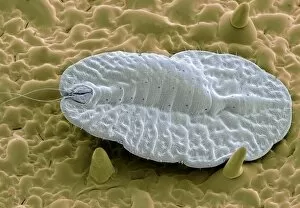Coccoidea Collection
Discover the intriguing world of Coccoidea, or Scale Insects, in the lush Napo River region bordering Yasuni National Park in the Amazon Rainforest
All Professionally Made to Order for Quick Shipping
Discover the intriguing world of Coccoidea, or Scale Insects, in the lush Napo River region bordering Yasuni National Park in the Amazon Rainforest. These tiny pests, as seen in SEM images C019 / 0305 and C019 / 0306, feed on plant sap and can cause significant damage to trees. Yet, they also play a role in the food chain, serving as a vital source of nutrition for predators like the Harlequin Ladybird larva, as shown in Genova Province, Liguria, Italy. The history dates back to ancient times, with fossilized specimens found in amber. The cochineal insect, a type of scale insect, has been cultivated for centuries for producing natural dyes and food additives, as evidenced by the cochineal plantations in Tenerife since 1873. Despite their small size, these insects have a significant impact on various ecosystems. For instance, Dactylopius coccus, another type of scale insect, can cause extensive damage to crops and trees. Yet, they also provide essential nutrients for other organisms, making them an integral part of the complex web of life in the Amazon Rainforest and beyond.









